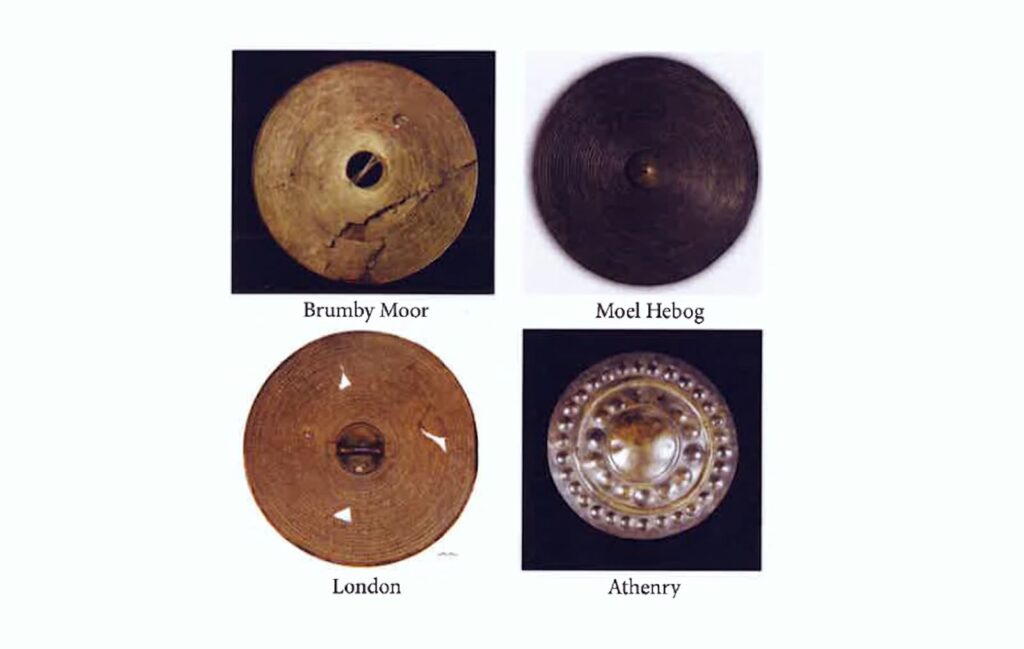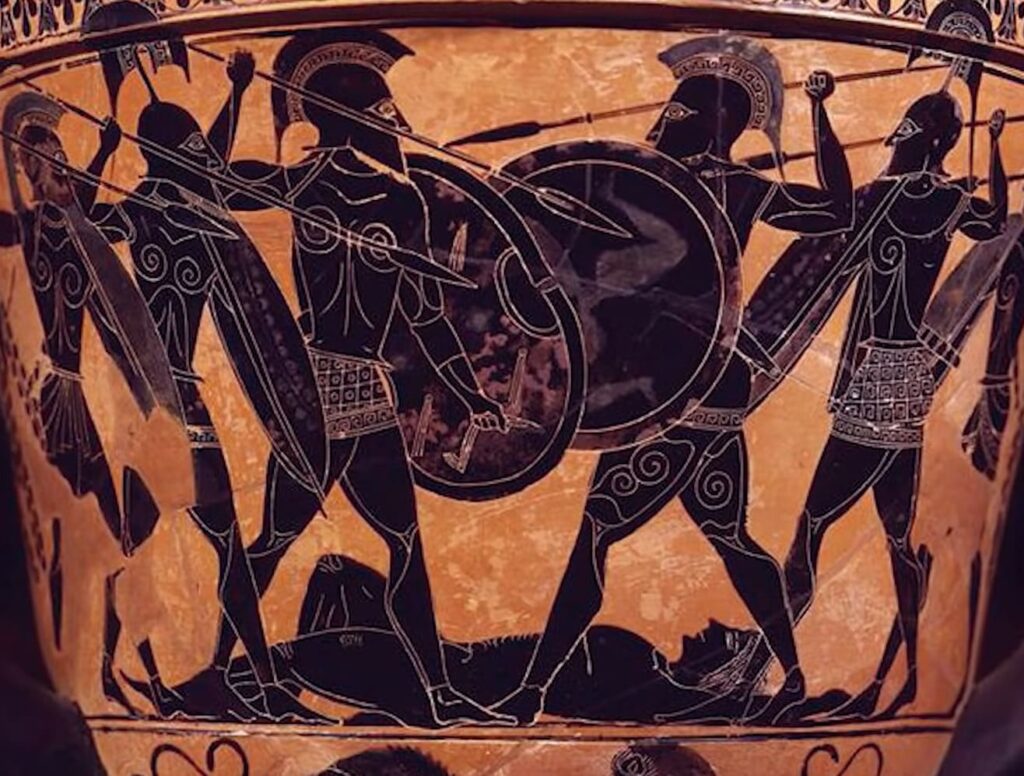Shields from the Bronze Age are quite uncommon, particularly those that are intact. These artifacts are usually adorned and crafted from slender sheets of bronze. The delicacy of these shields suggests they might not have been employed for defense. It is believed that these shields were symbols of status and authority, rather than practical tools for combat. Predominantly discovered in Britain and Ireland, it’s notable that none have been found in France, Belgium, or the Netherlands, indicating a unique cultural or geographical significance in their usage and distribution.
Exploring the intricacies of Bronze Age armaments, this examination of diverse shield types offers a compelling prelude to a similarly fascinating exploration of Bronze Age helmets, revealing the remarkable craftsmanship and design of ancient defensive gear.
Bronze Age Circular Shields: Design and Craftsmanship
Originating from 1300-800 BC, the Bronze Age Circular Shields, often referred to as Yetholm-type shields due to their association with Yetholm, Scotland, represent a unique class of ancient armaments. Predominantly found in Britain and Ireland, with a solitary example from Denmark, these shields are renowned for their distinctive construction and artistic design. In total, twenty-two such shields have been identified, some only in fragments, with an additional seven or eight known historically but currently lost.
These shields are notable for their varied sizes but uniform stylistic features. Similar motifs appear in rock carvings from Southern Scandinavia of the same era, suggesting a broader cultural significance. Though lacking the intricate detail of the Yetholm-type shields, these carvings display shields adorned with concentric rings or dotted patterns, hinting at a widespread recognition of this design.
The shields not only served as protective gear but were also symbols of high social standing. The crafting process highlights the sophisticated metalworking skills of the time. Made from a thin copper-tin alloy (approximately 0.6 mm thick), the shields feature a central domed boss and intricate raised ridges and hemispherical bosses, all formed through meticulous repoussé work. The outer edges are reinforced with a folded rim, and the shields include a handle and metal tabs for carrying straps, demonstrating both functional and decorative considerations.
The uniformity in the size and depth of the embossed bosses suggests the use of specialized tools, possibly a flanged punch, though no contemporary tool for this purpose has been discovered. The fine spacing of these bosses required skilled craftsmanship, evident in the seamless integration of design elements. This level of detail and similarity across the shields implies that they were likely produced in a single workshop by a select group of skilled artisans.
Diversity and Function of Bronze Age Circular Shields

The Bronze Age Circular Shields, exemplified by those found at various locations including South Cadbury, showcased at the Museum of Somerset in Taunton, exhibit a fascinating range of sizes and designs. These shields, dating back to as early as the 12th century BC, display a remarkable consistency in the size of their embossed features, despite variations in overall dimensions. The largest shield, unearthed in Ayrshire, boasts twenty-nine concentric ridges and a matching number of rings of bosses, while the smallest, initially believed to be from County Antrim but later identified as originating from The River Thames, has eleven of each.
These shields, often found in wet environments, display design elements that suggest they were not reinforced with wood or other materials. An exception is a shield from Lough Gur, believed to have had a leather backing. The embossed design and folded rim add some rigidity, but their effectiveness in combat has been debated. A 1952 experiment by archaeologist John Coles, using a copper replica of a Yetholm-type shield, found it easily cleaved by a bronze sword. However, further experiments by researchers Barry Molloy and Kate Anderson argue that bronze, the original material, is harder than the copper used by Coles, and that his replica may have been thinner than actual shields.
Design features like small handles, offering limited grip space, further suggest these shields were not primarily intended for combat. Some shields show signs of deliberate damage, possibly from ceremonial practices. The South Cadbury shield, for instance, was found pierced with a wooden stake. Metallurgical analyses by Peter Northover indicate these shields might have been created earlier than previously thought, around the 12th century BC, with the South Cadbury shield likely deposited in the mid-10th century BC.
Contrasting this notion, the Long Wittenham shield from Oxfordshire presents lozenge-shaped perforations, possibly from a spear, and other marks hammered flat, suggesting it may have seen combat.
The discovery of these shields predominantly in watery contexts, except for the South Cadbury example found by archaeologist Josh Williams, aligns with the broader ancient practice of depositing valuable items in such environments, potentially driven by religious or cultural beliefs, similar to those observed in other ancient societies like the Celts.
The Diversity of Bronze Age Shields

Type Nipperwiese
- Date: Comparable to a similar continental shield from the 13th century BC;
- Distribution: Found primarily in Northern and Central Germany, with a total of eight shields discovered, two of which are in Britain;
- Features: These shields are known for their sturdiness, with diameters ranging from 38 to 44 cm and a metal thickness of 1 to 1.3 mm. Weighing between 1.5 to 2.2 kg, they are relatively heavy and sparsely decorated, featuring only two concentric ribs.
Type Harlech
- Date: Circa 1300-975 BC, during the Penard to Wilburton metalwork phase, as indicated by associated finds and metal analysis;
- Distribution: Rare, with only four discovered in England and Wales, along with two closely related Trent variant shields;
- Description: These shields show significant variation in size and thickness, ranging from 50 to 68.5 cm in diameter and 0.1 to 1 mm in thickness. Weighing from 1 to 2.75 kg, they are adorned with six to ten concentric ribs; the Trent variants have 21 to 63 ribs.
Type Coveney
- Date: Also from the Penard to Wilburton metalwork phase, around 1300-975 BC;
- Distribution: Only two examples found, one in Aberdeenshire and one in Cambridgeshire;
- Characteristics: These shields are 47.5 to 52.5 cm in diameter with a metal thickness of 0.3-0.5 mm, each weighing around 1kg. Their unique feature is the meandering ribs that coil around the shield face, ending in snakeheads with punched-in eyes, suggesting a common origin or direct inspiration between the two.
Type Anthenry-Eynsham
- Date: Difficult to precisely date due to their isolated discoveries;
- Distribution: All six known examples are from Britain;
- Attributes: The smallest type thus far, with diameters of 23 to 35 cm, thicknesses of 0.3-1.2 mm, and weights between 0.9 and 1.2 kg. They are minimally decorated with a single concentric rib and occasionally one or two rows of bosses, and notably, they lack a rolled over rim.
Type Yetholm
- Example: Notable examples include BM 1873,0210.1 and 1862,1113.1;
- Date: Around 1300-975 BC, sharing the Penard to Wilburton metalwork phase with Types Harlech and Coveney;
- Distribution: Predominantly found in the British Isles, with 26 recorded examples and only one outside (in Denmark);
- Design: Larger in size, these shields range from 55 to 70 cm in diameter with a metal thickness of 0.4 to 0.7 mm, and weigh between 1.2 to 2.5 kg. They are distinctively decorated with alternating concentric rows of bosses and ribs, typically featuring 20-30 rows, although some have fewer rows with larger bosses.
Conclusion
The Bronze Age shields stand testament to the technological sophistication and artistic prowess of our ancestors. Their potential dual role in warfare and status symbolism paints a vivid picture of the societal complexities of the time. With each discovery, we unravel more about these stunning artifacts, allowing us a glimpse into the past while fueling curiosity for what remains undiscovered. Bronze Age shields provide extraordinary insights into the intersection of artistry, craft, societal hierarchy, and warfare dynamics of ancient civilizations. Whether primarily symbols of prestige and power or actual instruments of defense, their intricate designs and variations echo the remarkable capabilities of Bronze Age metallurgy and the creativity of the era.